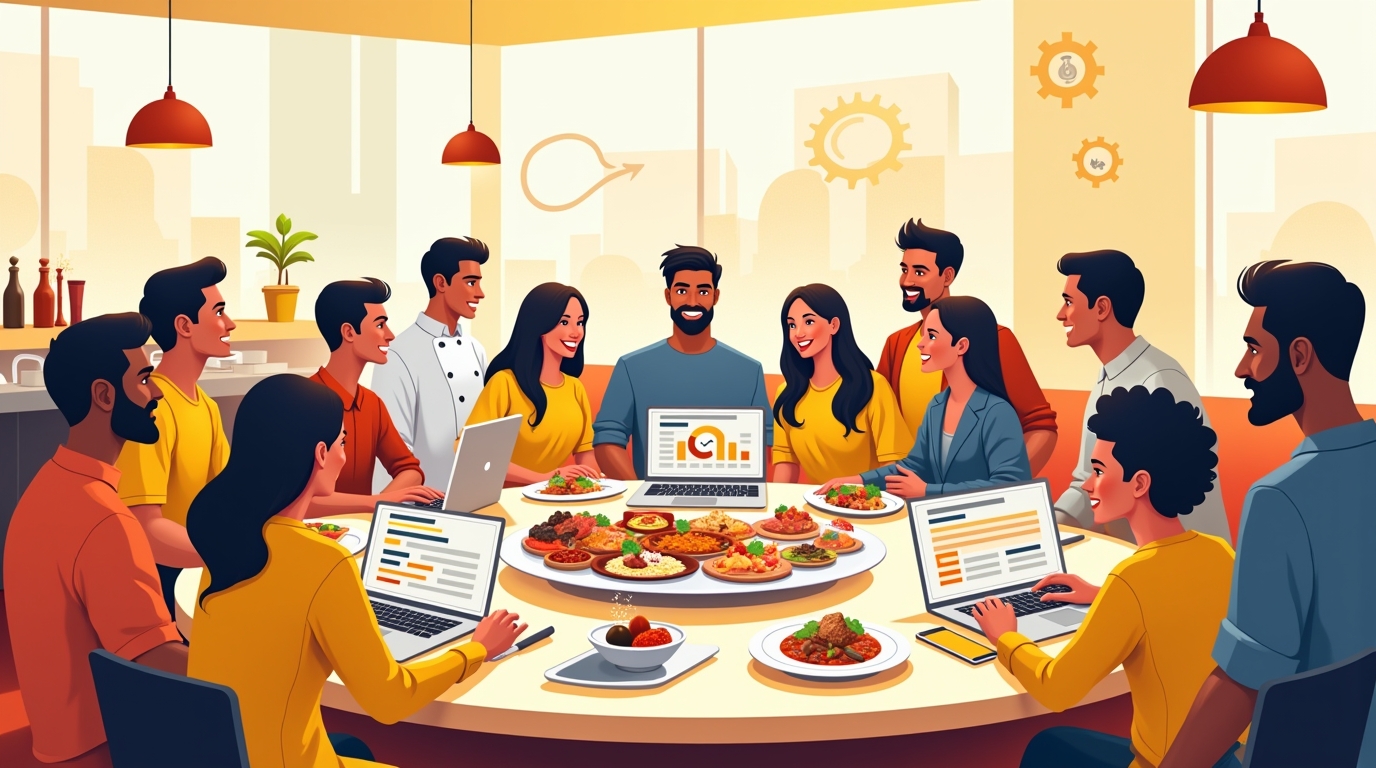Optimizing Your Restaurant’s Website for Delicious Results
The success of your restaurant in the current digital environment depends on how visible as well as the caliber of...

The success of your restaurant in the current digital environment depends on how visible as well as the caliber of your food and service. and enticing possible customers with your website. The first stop a customer often goes to is your website when they choose where to eat. You risk losing that company to rivals who have made the effort to enhance their web presence if it is not properly optimized.
We’ll lead you through the fundamental measures for improving your restaurant’s website in this article. Here is how you can make sure your website provides a digital experience as pleasing as your menu, from boosting SEO for restaurant visibility to improving the user experience:
1. Make Your Website Mobile-Friendly
Today, most people search for restaurants from their smartphones. Whether they’re looking for nearby dining options, checking the menu, or reading reviews, your website must be optimized for mobile. A poor mobile experience can frustrate users, which leads to higher bounce rates and fewer reservations.
What to do:
- Responsive Design: Ensure your website design adapts to various screen sizes. This is especially important for your restaurant’s menu, contact information, and booking system. A responsive design adjusts automatically to any device—whether a phone, tablet, or desktop—without losing functionality or visual appeal.
- Fast Loading Speed: Mobile users are particularly impatient when it comes to slow-loading pages. Aim for a loading time of under 3 seconds. Use tools like Google PageSpeed Insights to measure and improve the loading speed of your website.
- Simplified Navigation: On a mobile device, users should easily find key information like the menu, location, and hours. Minimize clicks by keeping important details accessible from the homepage.
2. Local SEO: Make Sure You’re Easy to Find
When people search for places to eat, they are usually looking for options that are nearby. Local SEO (Search Engine Optimization) helps you show up in search results when someone nearby searches for terms like “best restaurants near me” or “Italian food in [city name].” By optimizing your website for local search, you increase the chances of being found by hungry customers in your area.
What to do:
- Google My Business Listing: Claim and verify your Google My Business (GMB) profile. This is a powerful tool that helps your restaurant appear on Google Maps, the knowledge panel, and local search results. Make sure your GMB profile is complete with accurate business information like address, phone number, hours, and website URL.
- Local Keywords: Integrate local keywords into your website content. For example, instead of just using “Italian restaurant,” you could use “best Italian restaurant in [city name].” This helps search engines connect your business to local search queries.
- NAP Consistency: NAP stands for Name, Address, and Phone number. Ensure your NAP details are consistent across your website and all external platforms (like Yelp, TripAdvisor, or your GMB profile). Inconsistent information can confuse search engines and reduce your chances of ranking well.
- Local Backlinks: Consider working with local food bloggers, influencers, or news outlets to get backlinks to your website. These backlinks act as a vote of confidence for your restaurant and improve your website’s domain authority.
3. Optimize Your Menu for Search Engines
Your menu is one of the most crucial parts of your restaurant’s website. Not only is it important for customers looking to make a choice, but it can also play a role in your search engine rankings. By strategically optimizing your menu page, you increase your chances of being found by people looking for specific types of cuisine.
What to do:
- Descriptive Titles and Keywords: Use descriptive titles for your dishes and incorporate relevant keywords. For example, instead of just listing “Spaghetti,” use “Classic Spaghetti Carbonara” or “Spaghetti with Homemade Marinara Sauce.” Think about what your customers might be searching for.
- Organized Menu Layout: A well-organized menu not only improves the user experience but also helps search engines understand the content of your page. Use clear headings (e.g., “Appetizers,” “Entrees,” “Desserts”) and list dishes with concise descriptions.
- Include Prices and Ingredients: Always list prices and ingredient details. Search engines prefer pages with comprehensive information, and customers also appreciate transparency. Highlighting any specialty ingredients or dietary options (e.g., gluten-free, vegan) can attract specific search queries.
- Rich Snippets for Menus: Rich snippets are small pieces of information that appear in search results (like prices, ratings, or calories). If you use structured data markup for your menu, Google can display this information directly in search results, which could increase click-through rates.
4. Streamline the Booking Process
For restaurants that accept reservations, it’s essential to make the booking process as seamless as possible. If the process is complicated or requires too many steps, potential customers may abandon the site before completing their reservation.
What to do:
- Online Reservation System: If you don’t have one already, consider integrating an online reservation system (like OpenTable or Resy) that allows customers to book directly from your website. Make sure the system is easy to find, ideally with a “Reserve a Table” button prominently displayed on the homepage.
- Simple Forms: If you prefer to handle reservations manually, ensure that the reservation form is simple and straightforward. Avoid long forms or unnecessary fields—ask only for the essential details like name, phone number, and number of guests.
- Confirmation and Reminders: Once a reservation is made, send an automated confirmation email or text. You can also include reminders a day or two before the reservation to reduce no-shows.
5. High-Quality Visual Content: Tempting Food Photos
Photos play a vital role in showcasing your food and the dining experience. Poor-quality images can give the impression that your restaurant is outdated or unprofessional, while high-quality images can leave customers hungry and eager to book a table.
What to do:
- Professional Food Photography: Invest in professional food photography to showcase your dishes in the best light. High-quality images of your food will entice customers and provide a visual experience of what they can expect.
- Showcase the Ambiance: Don’t just stop at food photos—show the atmosphere of your restaurant. Feature your interior, outdoor seating, or even special events. This gives potential customers a glimpse of what dining at your restaurant will be like.
- Alt Text for SEO: When adding images to your website, include descriptive alt text. Alt text helps search engines understand what the image is about and improves accessibility for visually impaired users. For example, instead of just labeling a picture “pizza,” use something like “hand-tossed pizza with fresh basil and mozzarella.”
6. Enhance User Experience (UX)
The user experience on your restaurant’s website can make or break a potential customer’s decision to dine with you. If visitors struggle to find what they’re looking for or have difficulty navigating your site, they’re likely to leave and look for a competitor.
What to do:
- Intuitive Navigation: Your website’s menu should be clear and easy to use. Key information like your menu, hours, location, and reservation system should be easy to find. Avoid clutter and unnecessary distractions.
- Clear Call-to-Action (CTA): Every page on your website should have a clear CTA. Whether it’s “Order Online,” “Make a Reservation,” or “View Menu,” guide users toward the next step with obvious, actionable buttons.
- Accessibility: Ensure your website is accessible to all customers, including those with disabilities. Use readable fonts, high contrast colors, and alt text for images. Tools like the WAVE Web Accessibility Evaluation Tool can help you identify potential issues.
7. Add Customer Reviews and Testimonials
Customer reviews are one of the most trusted forms of social proof. A strong collection of positive reviews can be the tipping point for many potential diners. Not only do they provide credibility, but they also influence your restaurant’s search rankings.
What to do:
- Showcase Reviews: Display customer reviews and testimonials prominently on your website. If you don’t have a review section, create one. Consider adding a “Reviews” page or including snippets of positive feedback on your homepage.
- Encourage Reviews: After a meal, encourage customers to leave reviews on platforms like Google, Yelp, or TripAdvisor. You can even add a “Review Us” button on your website to make it easy for them.
8. Track and Analyze Performance
Finally, optimize your website based on data. Use tools like Google Analytics to track visitor behavior, bounce rates, page views, and conversions (like reservations or orders). By analyzing this data, you can make informed decisions about where to improve your site.
What to do:
- Monitor Key Metrics: Keep an eye on metrics such as user engagement, traffic sources, and conversion rates. These will help you understand what’s working and where there’s room for improvement.
- A/B Testing: Try A/B testing different elements on your website, such as CTA buttons, images, or menu layout, to see which versions perform better.
Conclusion
Optimizing your restaurant’s website is about more than just aesthetic appeal; it’s about creating a seamless, user-friendly experience that converts visitors into customers. From enhancing mobile performance to implementing local SEO strategies, the goal is to make your website as appetizing and easy to use as your restaurant itself.
By following the steps outlined above, you’ll be on your way to not only attracting more customers but also improving your website’s search rankings, making it easier for diners to find you, and keeping them coming back for more. Remember, in the digital



